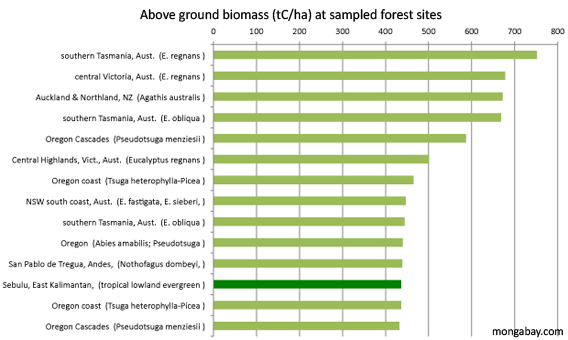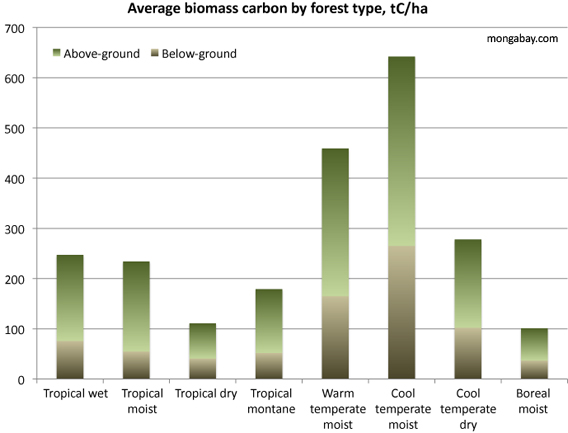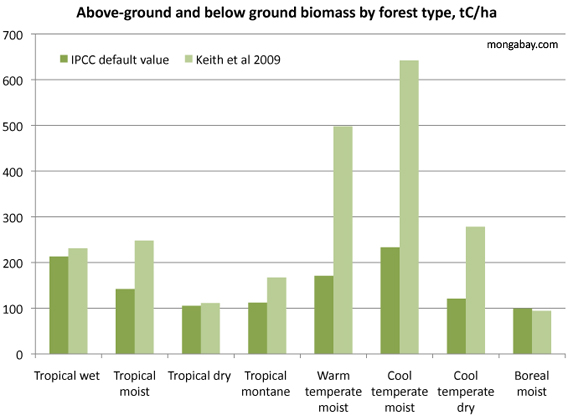Temperate and Boreal Forests - still a considerable carbon sink!
-----------------
A new report states that boreal forests store nearly twice as much carbon as tropical forests per hectare: a fact which researchers say should make the conservation of boreal forests as important as tropical in climate change negotiations.
The report from the Canadian Boreal Initiative and the Boreal Songbird Initiative, entitled "The Carbon the World Forgot", estimates that the boreal forest—which survives in massive swathes across Alaska, Canada, Northern Europe, and Russia—stores 22 percent of all carbon on the earth's land surface. According to the study the boreal contains 703 gigatons of carbon, while the world's tropical forests contain 375 gigatons.
"Past accounting greatly underestimated the amount and depth of carbon stored in and under the boreal forest," says Jeff Wells, one of the report's authors.
Researchers explain that while tropical forests store most of their carbon in vegetation, boreal forests store vast amounts of the greenhouse gas deep in permafrost soil and peatlands in addition to its trees. Cold temperatures prevent the complete breakdown of dead biomass in the boreal, so that carbon is accumulated over time, sometimes even millennia. Scientists have found carbon that has been locked away for 8,000 years.
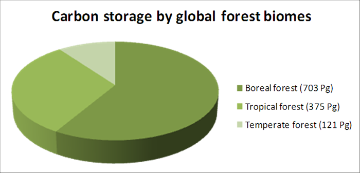 Breakdown of Carbon Stored by Global Forest Biome. Graph courtesy of "The Carbon the World Forgot" report. Breakdown of Carbon Stored by Global Forest Biome. Graph courtesy of "The Carbon the World Forgot" report. |
The focus on the tropics for conservationists and policymakers has been on the tropics, in part, because the majority of emissions due to deforestation are from tropical regions. Currently, far more topical forest is lost every year than boreal forest. In addition, tropical forests are home to the majority of the world's biodiversity.
Wells says that these findings should not change scientists' or policymakers' view that tropical forests require immediate protection, but only that boreal forests must also be included in negotiations if the world is to successfully to mitigate climate change.
"Any effective and affordable response to climate change should include preserving the world’s remaining, carbon-rich old-growth forests," said Steve Kallick, director of the Pew Environment Group’s International Boreal Conservation Campaign. "This report makes clear that nations must look not just at the tropics but at all the world’s old-growth forests for climate change solutions."
In fact, new studies have found that the amount of carbon locked away in the boreal forest may be 2-3 times even current estimations.
"Keeping that carbon in place by protecting boreal forests is an important part of the climate equation," says Dr. Andrew Weaver of the University of Victoria and lead author for the United Nations Intergovernmental Panel on Climate Change (IPCC). "If you cut down the boreal forest and disturb its peatlands, you release more carbon, accelerating climate change."
A recent study in Trends in Ecology and Evolution found that 60 percent of boreal forests are degraded and fragmented, while only 10 percent is currently under protection. Logging, mining, and purposely set fires are the leading causes for destruction in the boreal. Russia was found to be the worst manager of its forests out of the boreal states.
The IPCC recommended in 2007 that at least half of Canada's boreal forest should be protected from any development. Canada retains the world's largest intact forest.
The report adds its own recommendations: such as the inclusion of peatland carbon into international negotiations and mandatory accounting of all carbon emissions from forest management.
However, some scientists say that while protecting the boreal forests is very important, tropical forests should remain the priority at this time.
"It is almost entirely forest clearing in the tropics that currently contributes near 15-20 percent of global carbon emissions coming from deforestation. While maintaining boreal forest carbon stocks will certainly be a part of future climate change mitigation, it is important to remember that is it the aboveground portion of forest carbon stocks (not the soils where most of the boreal carbon is stored) that are under the greatest threat from human land use change," Holly Gibbs of Stanford University told Mongabay.com "The bottom line is that we need to work towards protecting the world's forest as a whole, but that the more than 340 billion tons of carbon stored in the tropics are under the greatest threat now and require our immediate attention."
Gibbs adds that "the 340 billion tons of carbon stored in the tropics is worth more than 40 years of worldwide emissions from burning fossil fuels."
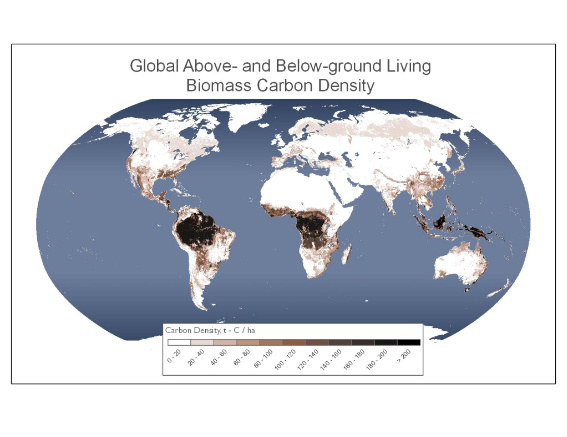 Ruesch, Aaron, and Holly K. Gibbs. 2008. New IPCC Tier-1 Global Biomass Carbon Map For the Year 2000. Available online from the Carbon Dioxide Information Analysis Center [http://cdiac.ornl.gov], Oak Ridge National Laboratory, Oak Ridge, Tennessee. Ruesch, Aaron, and Holly K. Gibbs. 2008. New IPCC Tier-1 Global Biomass Carbon Map For the Year 2000. Available online from the Carbon Dioxide Information Analysis Center [http://cdiac.ornl.gov], Oak Ridge National Laboratory, Oak Ridge, Tennessee. |
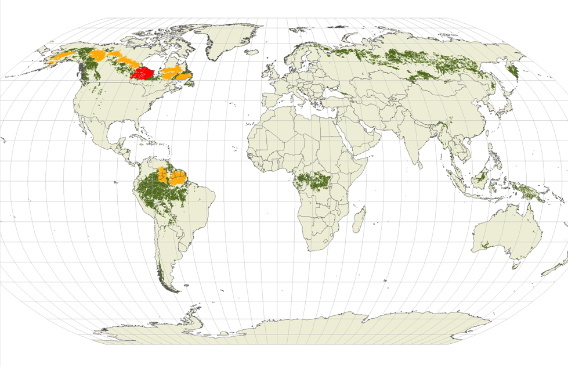 Top Intact Forests - largest in red, followed by yellow and green, representing forests undisturbed to date by humans. Map courtesy of "The Carbon the World Forgot" report. Top Intact Forests - largest in red, followed by yellow and green, representing forests undisturbed to date by humans. Map courtesy of "The Carbon the World Forgot" report. |
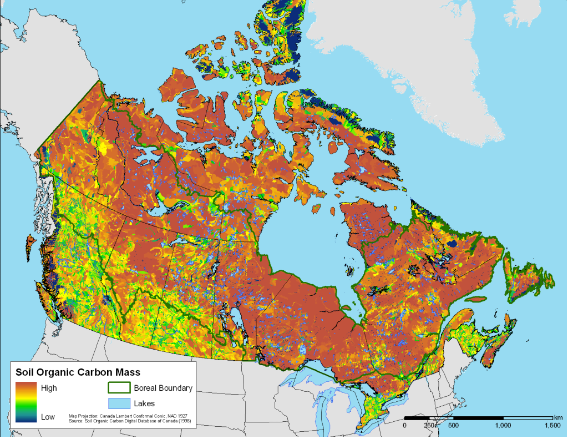 Soil Organic Carbon in Canada's Boreal Forest. Map courtesy of "The Carbon the World Forgot" report. Soil Organic Carbon in Canada's Boreal Forest. Map courtesy of "The Carbon the World Forgot" report. |
CITATIONS: "The Carbon the World Forgot" is based on a number of studies, including but not limited to:
Tarnocai, C., J.G. Canadell, E.A.G. Schuur, P. Kuhry, G. Mazhitova, and S. Zimov. 2009. Soil organic carbon pools in the northern circumpolar permafrost region. Global Biogeochemical Cycles 23, GB2023, doi:10.1029/2008GB003327.
Kasischke, E.S., Boreal ecosystems in the global carbon cycle, pp. 19-30 in Fire, Climate Change and Carbon Cycling in the Boreal Forest, Kasischke, E.S., and B.J. Stocks (editors), Ecological Studies Series, Springer-Verlag, New York, 2000.
IPCC (Intergovernmental Panel on Climate Change). 2000. Land Use, Land-Use Change and Forestry. R.T. Watson, I.R. Noble, B. Bolin, N.H. Ravindranath, D.J. Verardo, and D.J. Dokken (eds.). Cambridge University Press, Cambridge, U.K.
Gorham, E. 1991. Northern peatlands: role in the carbon cycle and probable responses to climatic warming. Ecological Applications 1(2): 182-195
Copyright:Issued by: Mongabay
Author: Jeremy Hance
e-Mail:
Issue date: November 12, 2009
Link to Article: Origin of this text
Temperate forests store more carbon than tropical forests, finds study
Temperate forests trump rainforests when it comes to storing carbon, reports a new assessment of global forest carbon stocks published July 14th in Proceedings of the National Academy of Sciences (PNAS). The findings have important implications for efforts to mitigate climate change by protecting forests.
Sampling and reviewing published data from nearly 100 forest sites around the world, Heather Keith, Brendan G. Mackey, and David B. Lindenmayer of Australian National University found that Australia's temperate Eucalyptus forests are champions of carbon storage, sequestering up to 2,844 metric tons of carbon per hectare (in above- and below-ground biomass), a figure that far exceeds previous estimates. These forests, located in the Central Highlands of Victoria in southeastern Australia, are dominated by giant Mountain Ash (Eucalyptus regnans) trees, which can reach a height of 320 feet and live for more than 350 years. They are also favored by the timber industry. Mountain Ash forests have been widely logged across Australia, with only limited old-growth stands remaining. In Tasmania less than 15 percent of Mountain Ash forests remain unlogged.
Overall temperate moist forests stored an average of 377 tons of carbon in above-ground biomass (vegetation) across 18 sites, followed by subtropical moist forests at 294 tons of carbon across 26 sites, tropical moist forests at 179 tons across 14 sites, cool temperate dry forests at 176 tons across three sites, and tropical rainforests at 171 tons across 18 sites.
|
|
The figures are substantially higher than default biomass carbon values used by the Intergovernmental Panel on Climate Change (IPCC) to calculate emissions from deforestation and degradation, and indicate that conservation of old-growth temperate forests should be a high priority in efforts to reduce greenhouse gas emissions from forestry. The study will likely embolden green campaigners seeking to bar logging from old-growth forests. The research has already upset the timber industry in Australia, which maintains that logging is "carbon-positive" (i.e. removes carbon from, rather than contributing it to, atmosphere). In an editorial published Thursday on Online Opinion, Austrlian forester Mark Poynter, argued that restricting logging in Australia would result in more emissions by shifting activities overseas to places where forest management is less stringent.
Heather Keith, Brendan G. Mackey, and David B. Lindenmayer. Re-evaluation of forest biomass carbon stocks and lessons from the world’s most carbon-dense forests. PNAS July 14, 2009 vol. 106 no. 28
Copyright:Issued by: Mongabay
Author: Rhett A. Butler
e-Mail:
Issue date: July 17, 2009
Link to Article: Origin of this text
---------------

